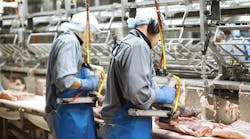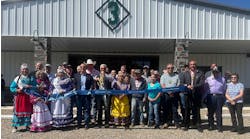In a bit from the cable TV comedy “Portlandia,” a couple orders chicken at a restaurant, and the server returns with a dossier, topped with a photograph:
“The chicken you’ll being enjoying tonight, his name was Colin,” she says. “Here are his papers.”
Today’s consumers are demanding nearly that level of transparency in their meat and poultry. And the technology exists to give it to them. Transparency and traceability are in great demand in food generally, and meat/poultry is arguably where the demand is most intense.
“The overarching trend, which has become more of a table stake, is personalization,” says Steve Hixon, strategic business services director at Midan Marketing, a meat industry consultancy. “Consumers want variety, a story, a brand to identify with and trust in what they are purchasing.”
The ability to track product as specifically as possible is important for establishing its wholesomeness, in terms of both safety and quality. Traceability allows microbial contamination and other situations to be pinpointed and brought under control quickly. It also allows companies to establish the bona fides of a variety of quality claims, such as organic and natural, and ones more specific to meat, like grass-fed, free-range and humanely raised.
These quality claims are becoming increasingly important. According to Innova Market Insights, the growth rate over the last four years for new products making various quality claims like grass-fed or cage-free ranged from 10% to 32%.
For processors, traceability is desirable in both directions in the supply chain: backwards to suppliers, and forward to trade customers and consumers. The idea is to assure each player that the previous one down the supply chain is delivering what was paid for.
Just BARE Chicken uses completely clear packaging to reinforce the idea of transparency.
Clear advantage
Some meat and poultry processors have built brands, or even entire companies, around the idea of wholesomeness and transparency. Just Bare Chicken, a brand of Pilgrim’s Pride, emphasizes wholesomeness and nutrition for its lineup of organic and natural products. Transparency extends literally to its packaging, which features clear trays and overwrap for a 360-degree view of the product.
“In the past several years, we’ve seen an increased consumer desire for transparency in where their food comes from and how it was raised,” says Kelsie McEndaffer, communications manager for Just Bare Chicken. “This increased interest in food production ultimately drives consumers’ willingness to pay a premium for food products that provide that transparency and, at the end of the day, instill trust.”
In addition to being organic and/or natural, Just Bare products are certified as humanely raised by American Humane, an animal-welfare nonprofit. American Humane certifies 10 other meat and poultry producers, in addition to Just Bare, as meeting standards for air and water quality, adequate space and other quality-of-life parameters.
Humane conditions for animals constitute a quality category that is “literally on fire,” according to Tom Vierhile, vice president of strategic insights-North America for Innova Market Insights. New product introductions in the U.S. with some variation of “humane” in the labeling or marketing grew 32.2% between 2014 and 2018.
“This suggests to me that worries over how animals are treated may be a significant purchase motivator,” Vierhile says. “I suspect that worries of this nature may be a big reason why consumers are gravitating to plant-based alternatives.”
Plant-based meat alternatives have been around for a long time, but modern technology is making them more palatable and appealing than ever. According to a study from Midan Marketing, 21% of meat-eaters consider themselves “flexitarians” – eaters of plant-based proteins in addition to meat. And the meat companies are getting in on the act.
Tyson Foods, which sold its stake in analogue meat company Beyond Meat just ahead of its IPO, is nonetheless betting big on plant-based protein. This summer it rolled out Raised & Rooted, its own brand of analogue chicken nuggets, made with a blend of pea protein isolate and other plant ingredients. It also has several products that combine meat with plant protein, like Aidells Whole Blends -- fully-cooked sausage links and meatballs made with a combination of chicken and plant ingredients, including chickpeas, black beans, quinoa, lentils and barley.
Perdue Farms also has opted to combine animal and plant protein in Perdue Chicken Plus, frozen formed nuggets, patties and tenders that combine ground poultry with chickpeas and cauliflower.
“We realized that the world probably didn’t need another bean burger or soy nugget. These would likely continue to appeal to 5% of people on vegetarian diets,” says Eric Christianson, chief marketing officer for Perdue Farms."
"We wanted to address the other 95%, and the growing number of flexitarians, about 30% of people who say they are trying to get more plants in their diet and/or reduce their meat consumption – for primarily health reasons.”
Source of info
Quality, safety and premium attributes like humane treatment all depend on information flowing across all parts of the supply chain – starting at the source.
Smart Data Science Solutions supplies software and data-analysis services for the poultry industry, mostly oriented toward growers. It can analyze a flock using historical data and machine learning in a way that will let processors know not only how many birds to expect, but what to do with them, says founder Timothy Buisker.
“A processor could use the salmonella prediction to determine when to process a flock, or which flocks to divert from raw product to cooked (those flocks with the highest likelihood for salmonella),” Buisker says. “They could use yield data to determine how to process the birds – into full breast meat or ground, for example – and, if the processor also has some control over the live operations, could act to try to avoid an outcome they don't want, such as instructing nutritionists to change the nutrition package at a certain farm to bring a predicted low-yielding flock up to standard.”
Data also can flow in the opposite direction – from the processor to the consumer. Traceability technology, especially blockchain, is a way to establish a product’s bona fides in a way that’s not open to doubt.
Blockchain, briefly described, is a way to use encryption to set up an unalterable digital “ledger” among participants across a supply chain. Its major application in food to date has been for safety, because it can trace shipments of food down to individual packages, facilitating recalls and enabling the origins of contamination to be pinpointed. But blockchain also has the potential to set up traceability from processors to trade customers and even consumers, providing them with a heretofore unimaginable degree of confidence that a product is genuine and wholesome.
Cargill is using blockchain to create a link between purchasers of its Honeysuckle White whole turkeys and the farmers who raised them. Consumers can trace their turkey back to the farm by entering a code from select packages into the Honeysucklewhite.com website and clicking the “Meet Your Farmer” button.
“Our industry needs to understand blockchain and embrace the future of authentic and secure AI (artificial intelligence) product tracking,” says Hixon of Midan Marketing. “However, blockchain is only as successful as the data input. As purchase decisions both B2C and B2D (business to distributor) become more commonplace, secure and authentic transactions will be necessary.”
Meat consumption has always sparked nutritional concerns, especially with processed products like sausage. A new additive, based on potatoes, has the potential to improve the nutritional profile of processed meats without sacrificing taste.
Botaniline applies a proprietary cooking and grinding process to potatoes that increases their binding qualities, becoming “almost like food-based glue,” says Mark Celmer, Botaniline’s CEO. The mixture can take the place of sodium and other negative nutrients in processed meats, making them easier to form while cutting back on sodium, fat, saturated fat and calories.
Botaniline was developed in conjunction with Wardynski & Sons, a 100-year-old family-owned manufacturer of sausage and other processed meats in Buffalo, N.Y. Wardynski & Sons began using Botaniline for institutional products, including hot dogs it started furnishing to the Buffalo Public Schools in September.
The hot dogs with Botaniline are 110 calories each (35% less than the hot dogs the schools had been serving), with 360mg of sodium (33% less) and 4g of saturated fat (56% less), while being higher in protein and iron. And according to the school district’s foodservice director, the kids like them.
The company is now using Botaniline for some retail products, including its kiszka sausage, says CEO Raymond “Skip” Wardynski.
“Our kiszka is remarkably better now that we use [Botaniline],” Wardynski says. “It keeps all that good stuff right in there. I got guys who work for me that ate it their whole life, and they are stunned by just the taste and what that potato does, maintaining all those flavors.”
Cracking the code
Blockchain is one of the newest traceability technologies for food, but it’s by no means the only one. Established coding technology, properly used, can trace shipments down to the case level.
FoodLogiQ provides software that uses GS-1 standards with GS1-128 barcodes to achieve traceability across the supply chain, says Julie McGill, VP of supply chain strategy and insights. McGill calls traceability “often a blind spot for companies. Their ERP [enterprise resource planning] system may manage the production of products and identifying batches and lots, but they can lose visibility once these products go out the door.” One of FoodLogiQ’s most prominent customers is Tyson Foods.
Processors who want to use FoodLogiQ will often need to upgrade their information-handling capabilities. This can include both equipment, such as coders that can print and apply case-specific barcodes, and the capacity to store and analyze data like product number, batch/lot (or serial) number, case dates, quantities and other critical information.
“This is data that suppliers are already capturing today, but they may not be aggregating it or sharing the data in a standardized way,” McGill says. “Moving to GS1 standards streamlines this process, and using FoodLogiQ allows companies to visualize products across their entire supply chain.”
Tight labor markets have posed challenges in staffing for meat and poultry processors. Photo: Danish Technological Institute
Working on labor issues
Automation has become a priority across the food industry. A tight labor market means trouble attracting floor workers, especially in meat and poultry, where working conditions often tend to be unattractive – cold, wet, fast-paced, repetitive and occasionally dangerous.
Robotics offers a long-term solution, but many practical challenges remain, especially on the processing side. Tyson Foods made a long-term commitment to robotics with the August opening of the Tyson Manufacturing Automation Center near its Springdale, Ark., headquarters. The two-story, 26,000-sq.-ft. facility includes a machine vision technology lab.
Another processor going into robots in a big way is JBS, the world’s largest meat company. In 2015, JBS bought a controlling share in Scott Technology, a New Zealand-based robotics supplier.
The underpinnings of Scott’s meat-processing robots are vision, both camera and X-ray, and image analysis, says Andrew Arnold, director of meat processing. Because animal carcasses are not uniform, the robots have to be able to see, analyze and learn.
“Enabling automation in the meat industry, particularly around boning, has been around understanding the structure of the animal and being able to cut accordingly,” Arnold says. “We developed X-ray systems and camera technologies and imaging analysis which has enabled us to deal with the continually varying product.”
Image analysis through machine learning allows Scott equipment to deal with challenges like varying numbers of ribs in a carcass. “We scan it, and we analyze those scans with algorithms to determine exactly where we need to cut,” Arnold says. “We would train it as to where we would cut it, and then the algorithms would then determine that point on other animals.”
Robots often can cut meat better than humans, in terms of harvesting prime, high-value cuts with more flesh on them. In fact, the benefits from that can outweigh the labor savings, Arnold says: “The yield payback is far greater than the staff savings.”
Processors, retailers and consumers want meat and poultry that’s wholesome, reliably sourced, and handled as safely and efficiently as possible. A variety of technologies exist or are being developed to meet all those goals.


